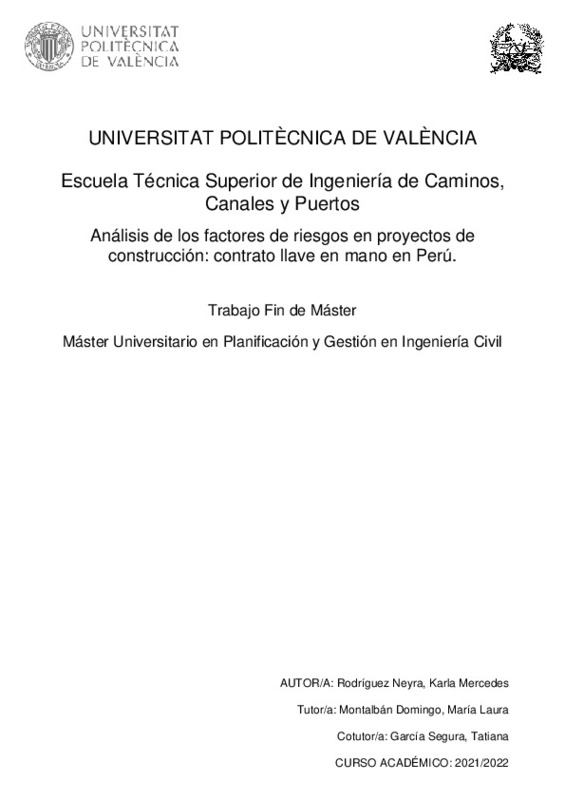|
Resumen:
|
[ES] La gestión de riesgos de un proyecto de construcción se considera un elemento clave para el éxito del proyecto. Los proyectos de construcción son únicos y tienen un inicio y fin de tiempo, por lo que se debe realizar ...[+]
[ES] La gestión de riesgos de un proyecto de construcción se considera un elemento clave para el éxito del proyecto. Los proyectos de construcción son únicos y tienen un inicio y fin de tiempo, por lo que se debe realizar un análisis detallado de los riesgos que pueden ocurrir durante el ciclo de vida de la infraestructura; ya que, si no se analizan de una manera preventiva todos los problemas ocasionarán impactos negativos tanto de coste como de plazo en el proyecto. Por esta razón se debe identificar, evaluar, analizar, monitorear y controlar los diferentes tipos de riesgos que pueden ocurrir en el diseño, construcción y puesta en servicio del proyecto. Los contratos llave en mano se utilizan para disminuir los costes y plazos en el proceso de licitación del diseño y construcción del proyecto, ya que en un solo proceso se lleva a cabo la licitación del diseño y su construcción. Además se responsabiliza al contratista por los diseños, lo cual reduce en principio los riesgos asociados a "errores de diseños", los cuales son una de las principales causas de conflictos y sobrecoste en la obra. En este trabajo se busca analizar los diferentes tipos de riesgos que aparecen en los contratos llave en mano. Para ello, el trabajo realiza una revisión de la literatura de artículos científicos de contratos llaves en mano. Posteriormente, a través de una encuesta respondida por expertos de Perú se analizaron los riesgos más importantes en los contratos llave en mano de Perú y las causas más influyentes que generan dichos riesgos en las obras. Este trabajo es de gran importancia para la industria de la construcción, ya que el análisis de los riesgos que se originan en contratos llave en mano puede ayudar a prevenir o minimizar los impactos negativos y trabajar de una manera eficiente.
[-]
[EN] Risk management in construction is considered a key element for the success of the project. They usually always appear in construction works at the beginning, during and at the end, which is why it is considered an ...[+]
[EN] Risk management in construction is considered a key element for the success of the project. They usually always appear in construction works at the beginning, during and at the end, which is why it is considered an important part of the work. Construction projects are unique and have a start and end time, for which a detailed analysis of the risks that may occur during the life cycle of the work must be carried out; Since, if all the documentation you have is not analyzed in a preventive manner, it would cause problems both in terms of cost and time in the project.
When using the turnkey contracts in the works, it is presented as an effective means to reduce costs and deadlines in the bidding process, since in a single process the bidding for the design and construction of the project is carried out; The responsibility of the designs is on the part of the contracting party, so it reduces the associated risks at the beginning, these are a normal cause of conflicts and cost overruns of the works. In the different stages of project development, the first design phase is the one in which changes can be made and greater savings generated, which is why it is very important to detect risks and make the best decisions about the solutions to be carried out. As the life cycle progresses and the construction stage begins, this flexibility decreases and the effort to make changes increases, which generates delays and cost overruns. For this reason, the risks of both the promoter and the contractor are evaluated. Each method must be subjected to the identification of the associated risks for each of the parties, add the preventive measures and assign the residual risk to the party that is in the best position to absorb it.
The research seeks to analyze the different types of risks that appear in turnkey contracts. The work consists of carrying out a literary review of scientific articles on turnkey contracts. The result of this review was to collect and classify more than 60 types of risks. Subsequently, through a survey answered by experts from Peru, the most important risks in the turnkey contracts in Peru and the most influential causes that generate said risks in the works are analyzed. 25 causes divided into 5 categories were obtained to carry out the study. An attempt is made to find out what are the causes of the different types of risks that appear in the works, which generates delays and cost overruns. Then the relationship between the categories of each of the causes of the risks is analyzed.
The purpose of this work is to serve as a guideline for people interested in construction projects who wish to carry out risk management in their companies or organizations, in order to prevent or minimize negative impacts and work efficiently.
[-]
|







